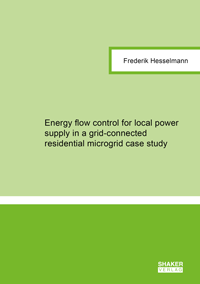
Shop : Details
Shop
Details
45,80 €ISBN 978-3-8440-8575-4Softcover130 pages33 figures191 g21 x 14,8 cmEnglishThesis
May 2022
Frederik Hesselmann
Energy flow control for local power supply in a grid-connected residential microgrid case study
The focus of this work is the development of a scalable and flexible control strategy for the local energy supply of residential districts. The problem arises from the coordination of two generation systems, based on combined heat and power on the one hand and photovoltaics on the other. Both systems complement each other when energy production is considered over the year, but in the short term an unfavourable over- or undersupply in the power curves can be observed. The energy system is characterised by control variable limitations, non-linearities and continuous and non-continuous control variables. With model predictive control, these can be suitably addressed, including the economic cost consideration.
With the implementation of such a district supply, the forward-looking joint project GreenEnergyFirst provides the framework conditions for the development of an energy system simulation.
For this purpose, the model components are presented and identified with measurement data. In addition to the simulation based on detailed models, this also allows predictions based on simpler models.
Finally, the control strategy is applied to the simulation and compared to the common heat-led combined heat and power plants.
Compared to the state of the art, the control strategy was further developed. The developed and identified models offer added value for future system and controller designs beyond the case study.
With the implementation of such a district supply, the forward-looking joint project GreenEnergyFirst provides the framework conditions for the development of an energy system simulation.
For this purpose, the model components are presented and identified with measurement data. In addition to the simulation based on detailed models, this also allows predictions based on simpler models.
Finally, the control strategy is applied to the simulation and compared to the common heat-led combined heat and power plants.
Compared to the state of the art, the control strategy was further developed. The developed and identified models offer added value for future system and controller designs beyond the case study.
Keywords: Model predictive control; flexible combined heat and power; district supply; energy flow control
Export of bibliographic data
Shaker Verlag GmbH
Am Langen Graben 15a
52353 Düren
Germany
Am Langen Graben 15a
52353 Düren
Germany
Mon. - Thurs. 8:00 a.m. to 4:00 p.m.
Fri. 8:00 a.m. to 3:00 p.m.
Fri. 8:00 a.m. to 3:00 p.m.
Contact us. We will be happy to help you.



